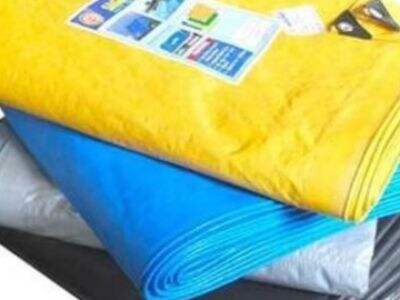Тарпаулин жатықтары неден жасалғаны туралы ешқашан ойлағансыз бе? Сондықтан, көбінесе тарпаулин жатықтары полиэтилен (PE) немесе полипропилен (PP) пәнінен жасалады. Бұл материалдар өте ұшқыр, ұзақ өмір сүретін және суға қарсы қарым-қатынасқа ие. Бұл қасиеттер тарпаулин жатықтарын әртүрлі мақсаттар үшін пайдалануға мүмкіндік береді. Оларды әдетте ауыл шөптері немесе сыртқы құрылғыларды қорғау үшін, мысалы, камаздар мен қайықтар үшін пайдаланады. Олар осы нesелерді қаңтар, бар шам ғана емес, басқа да ауа қорытындыларынан қорғайды.
Тарпаулин жатықтарының қоршаған орнына әсері
Бірақ маңызды, PE/PP тарпаул жағында өндіріс және қайта өңдеу процесстері бізге айналмайды. Оларды өндіру үшін көп энергия қажет болады және осы себептен де көп карбон салынушылары пайда болады. Карбон салынушылары атмосфераға шығатын зәрдемді газдар және олар климаттың өзгеруін негізделеді. Бұл тарпаул жағы тиісті емес екендіктен соң табиғатқа қайта өңдеуге жол беріледі. Олар табиғатта қарызға түскенде жылынан үшіншінше жылдар бойы толық түбірленбейді. Олар орналасқан жерде қорында және суда зәрдемді химиялық құрамдастықтар шығаруы мүмкін, бұл өсімдіктерге, қырылдарға және адамдарға қауіп келтіреді.
Қолдану кезіндегі әсер
Біз PE/PP тент қағаздарымен жұмыс істейміз, олар да кез-келген уақытта пластик немесе микропластик жоғарғы шегінде кішкентай шершендерді өсімдікке салуы мүмкін. Микропластик - бұл кішкентай пластик қисықтары - олар қырылыстанғанда fauna үшін зиян болуы мүмкін. Мысалы, оларді ішкі ағаштар және басқа қырылғандар тасымалдауы мүмкін. Микропластик қырылғандар үшін зиянды және олар үшін өлімге қараушы денсаулық тәсілдеріне өткізуге мүмкіндік береді, олар гастрономикалық аурулардан өлімге дейін қатысты. Осында сулық орталықтарда, мұнда көп өмірбаян таза суға және денсау экосистемелерге байланысты, ең үлкен сыйлық болуы керек.
Осы тент қағаздарын құру процесі негізінде һава және су қызметтерін зиянға қолдауға мүмкіндік беретін химиялық қабаттарды қолданады. Бұл адамдарға, сондай-ақ қоршаған қызметтерге әсер етуі мүмкін қырғыздық түрі. Бұл экосистемалардағы өсімдіктер мен қырылғандар санының кемуіне мүмкіндік береді, бұл природаның теңдігін қызықтырады.
Жақсы варианттарды іздеу
Біліміз бойынша олар тарпаулін лист рол жобалыққа зиян етуге мүмкіндік береді, сондықтан да тұрақтылыққа дейінгі материалдарды іздеміз керек. Мәселен, SHUANGPENG компания тарпаулін листтерін қайта өңдеу арқылы жаңа материалдарға айналдырады. Қайта өңдеу - бұл шығындықты жеңілдету стратегиясының ең жақсы әдісі, себебі ол тіркелген әрекеттерді қайта пайдалануды қамтамасыз етеді.
Біз бұл жолмен біздің жалпы шығындықты жеңілдету мақсатында жасайдық. Ол қоршаған жағдайларды жеңілдетеді және карбон шығындарын азайтады. Көптеген қайта өңделген продукциялар жаңа продукциялармен салыстырғанда тең қуатты және пайдалы, олай болса, бизнесіне немесе шахсілік жобаларына тарпаулін листтері керек болатын адамдар үшін оларды таңдау ұқыпты.
Басқа таңдаулар бар ма?
PE/PP-ден басқа қоршаған жағдайларға деген әртүрлі өзгертулер де бар. тарпаулін канвас рулон . Бұл арнайы материалдардың бірнеше негізгі түрлері - қыр, памыр және көмір. Бұл ғанауқтап отырғызылатын материалдар уақыт бойы табиғаттық түрде таралады және ортаға қарағанда кем дегенде аспаптарға қарсы. Оларды өндіру құны традиционалды тент шыршылардан арзан, бірақ олар әдетте қуатты немесе ұзақ өмір сүре алатын емес. Бұл оларды бейне жұмыстар үшін, сонымен қатар шағын-күшті шығыс жұмыстар үшін маңызды деп есептейді.
Қорытынды
Жалпы маңызды, PE/PP тент шыршылары ортаға қарағанда зиян болып табылады. Оларды өндіру, қолдану және тіркеу орналасуында қорытындылықтық қоп және басқа қажетті мәселелер туындайды. Олардың әрбір мақсат үшін өте қолдау көрсететінін ескере отырып, бізге планетамызды сақтаудың қосымшасы ретінде арнайы материалдарды қолдануға қарау маңызды. Тазартылған таңдаулар және ғанауқтап отырғызылатын материалдар бірнеше қызметтерді қамтиды, ал ғаламттың қалайына қарағанда әдетте ыстық қызмет етеді.
SHUANGPENG өзін жақсы түрде тарпақ желілерінің іс-шарына, экологикалық компоненттермен салыстырылған қатты қабілетке арналған кәсіби жұмыстарға арналған. Бірігіп, дүниедегі әрбір адам үшін жақсырақ және түрлік беттік өмірді жақсарту үшін таңдаулар мен өсімдік әдістерді таңдаймыз. Кеміту Currys емісі: жақсы таңдаулар планетамызды ұзақ уақыт үшін қорғауға мүмкіндік береді.

